Monuments in St MaryMagdalene Church, Richmond, S. London
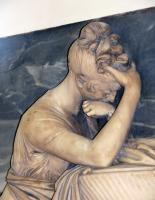
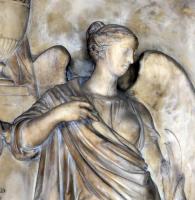
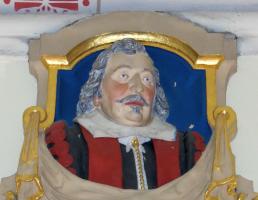
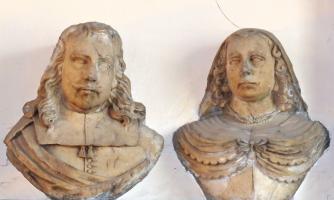
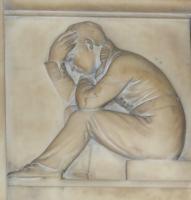
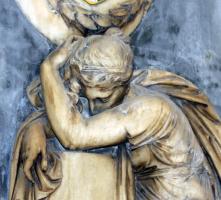
Richmond forms a South-West outer London borough, and is also within the historic confines of Surrey.
The Church of St Mary Magdalene, Richmond, is a long building, with a short castellated tower at the front,
mostly the work of 1750 on an older base. The chancel, as is noted on panels on the walls, is of 1904, G.F. Bodley being the architect.
Around the inside of the church are a large variety of monuments – some 60 in all, dating from the 17th through to the
early 20th Century, including a goodly number with sculptural ornament, and several with figure sculpture.
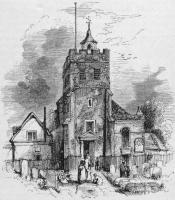
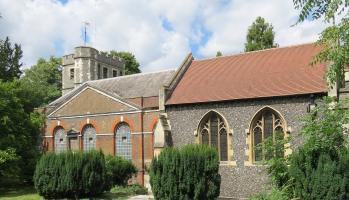
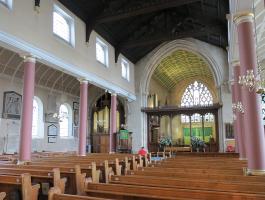
Richmond Church, 1850s view of tower, exterior and interior.
17th Century Monuments:
The collection of 17th Century wall panels is good, with one from almost every decade, and between them give a fair idea
of the typical range of kneeler monuments, and portrait types.
- Walter Hickman MP, d.1617, of St Dunstan in the West and Kew. A conventional kneeler monument.
The deceased is shown kneeling, praying, in front of a short prayer desk, raised up rather on the tasselled cushion
which is always found in such monuments (see this page for more on such things), and wearing armour and a ruff. He is bearded. The figure is painted,
probably several coats by now, which is often the case, and we cannot tell how finely carved the face and hands would once
have been: the sculptor would have been working from at best a painted portrait, so the face is of a type rather than likely
to be much of a true likeness. As usual, the figure is within a niche under an arch, rounded in this case, which is common,
with Corinthian attached pillars to left and right, an entablature and upper shelf, with upon it a large cartouche with his arms
and the usual knight’s helm with flowery feathers. Beneath, the very worn inscription is on a dark oval
on an apron carved with scrolls, crossed spade and pick, and crossed bones, and to the sides, two brackets bearing shields.
Two more shields on the spandrels. There are further small details, including flowers under the upper and lower shelves,
and small winged cherub heads beneath the pillars.
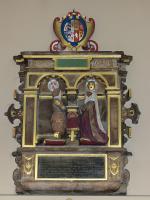 Margaret Churleigh, d.1628, typical kneeler monument.
Margaret Churleigh, d.1628, typical kneeler monument.
- Margaret Chudleigh, d.1628, daughter to Sir William Coutney of Powderan, Kt, whose second husband was
Sir John Chudleigh, who erected the monument. A pair of kneelers, facing each other across their prayer desk,
with arms folded at first glance folded rather than praying, until you notice that the hands, which would have been praying,
have been broken off. They kneel on the usual cushions. He is armoured, and bearded; she wears a long shapeless dress,
which is characteristic, but has a rich ruff, sleeves, and wears a long headpiece which hangs down over her back.
Each figure is within their own niche under a rounded arch, with a central pilaster, carved with acanthus, going down behind
the prayer desk. To the side, plain pilasters, above, an entablature and a large cartouche bearing the painted arms.
The arms of the two families are also above their heads. Beneath, the dark inscription is on a heavy panel with curved base.
To the sides are cut outs all the way up, with part-wheels, flowers, and scrolls; a sort of design usually found as
a space-filling device on a flat monumental backing rather than a border, but here giving a most effective and striking outline.
The whole in a brownish marble, much gilded and painted.
- Ladie Dorothie Wright, d.1631, wife to George Wright, with a worn inscription on a black panel,
beneath a significant Kneeler monument. Husband and wife, each under within their own arch as we have seen previously,
kneel facing each other praying across a prayer desk in the usual fashion. He is partially armoured, and bareheaded,
and has a beard. She is dressed in a cowl and cloak, and has an unusually large neck ruff. Rather solid figures,
and the painting makes them look very wooden, albeit youthful. Above her head, a coat of arms on an elongated roundel,
but that above her husband has been lost. A larger coat of arms is at above the entablature and crowning shelf,
and to the side are free standing Corinthian pillars. Beneath, smaller kneeling figures represent their children:
three male and four female, with three swaddled infants. The convention is that the boys are under the father,
the girls under the mother, and there is the usual family resemblance to the point of duplication. The male offspring
are somewhat rotund even by 17th Century sculptural standards, but the two youngest girls are more slender,
here indicating youth at the time the monument was made. A variety of minor ornamentiaton, including skulls
are next to the inscribed panel.
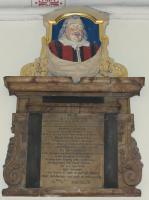 Robert Lewes, d.1649, with painted bust.
Robert Lewes, d.1649, with painted bust.
- Robert Lewes, d.1649, with Latin inscription, the tablet with black side pieces flanked
by ornate outer borders in alabaster, carved with flowers, the basic shape being a scroll at the bottom and more slender above,
which is a common design. There are shelves above and below the inscribe panel, and at the top, a large, painted bust of
the deceased. He is shown rather plump, with something of an open-eyed surprised look, mitigated somewhat by the
magisterial effect of his hair, down to the shoulder, and the chain of office on his breast. Perhaps his owl-like gaze
arises from the monument being painted; many or most monumental figures of this period are painted, yet when we see the
unpainted ones, there is often a subtlety and delicacy of treatment lost in the painted pieces.
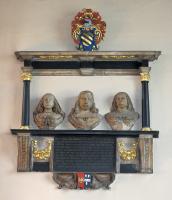 John Bentley, wife and daughter, 1660s.
John Bentley, wife and daughter, 1660s.
- John Bentley, d.1660, wife Ellenor, d.1657, and daughter, also
Ellenor, d.1656, by an earlier husband, and four of the second Ellenor’s 15 offspring.
Dark panel with shelf above on which rests busts of the three deceased, he centre, flanked by the two Ellenors.
He has a moustache, long flowing hair, but no beard, and wears a wide square collar with a buttoned shirt below,
covered by a robe. The wife and daughter, extremely similar to each other in appearance, have ringletted hair at the sides,
almost none on top, and a covering hood far back. They have upper garments tied in the centre with bows,
and each wears a necklace and earrings. All three have similar, sad-looking mouths, perhaps not inappropriate
for funereal representations contemplating their own demise at no great age and so close to one another.
To left and right, Corinthian pillars in black marble suppor an entablature and shelf, with central coat of arms
on top on a cartouche. On left and right of the panel below, small festoons on the backing, and large brackets;
at the base, a small shield at arms with minor drapery forming an apron. The monument would appear to be the remaining parts
of a more conventional piece, certainly with a backing panel and likely with more on top and more at the sides.
A significant monument nevertheless. The sculptor was at one time suggested by Cherry and Pevsner (presumably the former)
to be by the sculptor Thomas Burman, who worked at one time for Edward Marshall and was the errant master of John Bushnell.
- Mary Wingfield, d.1677. On a black panel, much worn, with a long Latin inscription,
and above that an arched pediment with stone surround; the sides and base of the memorial are missing.
- Richard Brawne, d.1682, with a brief Latin inscription and a poem in English,
in flowing script. Black panel, with upon it a coat of arms with much acanthus and two feathery side extensions,
with a heavy border of browned marble.
- Marc Antoine Benoii, d.1687, ‘Natif of Montauban, France’, domestic to various nobility.
Elegant text on a white panel with thin upper shelf.
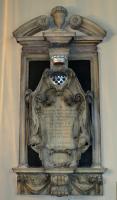
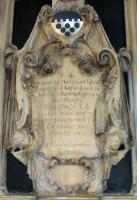 Viscount Brouncker, d.1687/8, a finely carved cartouche.
Viscount Brouncker, d.1687/8, a finely carved cartouche.
- Henry Lord Viscount Brouncker, d.1687/8, of Castle Lyons in Ireland,
‘Cofferer to his Majesty King Charles ye 2nd’, noting his Executor was Sir Charles Lyttelton.
Inscription on a cartouche, with curls, acanthus, hanging drapes, and two small cherubic heads;
smaller cartouches at the top and bottom, the former with a coat of arms.
All this on a black rectangular backing with surrounding frame, broken curved pediment on top with an urn,
and thick base with drapes etc. Cartouches are among the most beautiful of monuments, this being rather an early one,
and it is unusual to have one within a Classical frame: compositionally, the frame is essentially an architectural design,
while the Cartouche is a sculptural one with no reference to architecture. Regardless, the carving is extremely good,
the roses at the top and the surrounding flowers showing a feeling for natural form. Although the casual visitor
will generally be drawn to the figure sculpture, this monument is perhaps the one to linger on.
- Rt Hon the Lady Sophia Chaworth, d.1689, 4th daughter of Robert Earle of Lindsey,
Lord Great Chamberlain of England, and of Elizabeth daughter of the Rt Hon Edward Lord Mountague of Boughton,
‘a Lady worthy of soe great a Parentage’, erected by her brother The Hon. Robert Bertie.
Black panel in front of a stone border, marble pilasters to the side with gilt acanthus leaf capitals,
shelf above bearing a broken pediment enclosing a large cartouche with coat of arms with a jelly-mould style urn
at the top in black marble. At the base, a down-curving shelf to match the urn, with shell-like corrugations (gadrooning)
above a stone apron. At the top of the main inscription below the pediment hangs suspended a winged cherubic head,
mouth open perhaps in song, with two hanging drapes. The quality of carving of this head is far above the norm
and avoids the sentimentality common to a later age; rather sophisticated.
18th Century monuments with carving:
- Simon Bardolph, wife Ann, and various members of their family, noting the last surviving
grandson Henry Stobart, d.1702. An interesting curved monument, with the inscription as if on a shroud, knotted
at top sides and centre, hanging at the sides; an arched top, pilasters at the side in three-quarter view,
and a large apron bearing shield at arms and with a winged cherubic head at the base.
Curved monuments like this were sometimes made to hang on pillars, but presumably not in this case.
- Lt-Col Charles Floyer, d.1731, and wife Jane, d.1759, and sons Charles, d.1766,
and Wills Floyer, d.1738 in the East Indies, and a note that he was ‘Descended from a very Ancient Family,
lately of Floyer-Hays in the County of DEVON’. The inscription with in a shaped panel with a narrow border,
with a broad surround heavily carved into a military trophy (that is to say, a group of weapons arranged crossed over
each other, splayed out), here largely concealed underneath the central panel. We see heavy cannon, swords,
trumpets, flags, knights’ helms and drapes. At the top, a shield of arms with head of some beast, perhaps a bull,
and at the base, swirly scrolls and a central cartouche bearing a shield of arms. Unusual.
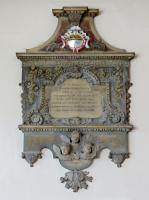
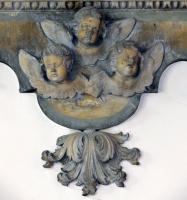 Randolph Greenway, d.1754, Classical baroque.
Randolph Greenway, d.1754, Classical baroque.
- Randolph Greenway, d.1754, a panel with upper and lower shelf, rather baroque
truncated pediment, with an upper shelf of its own and a central pilaster behind a shield at arms, and below,
an apron with three winged cherubic heads carved as a group, and acanthus brackets below centre, left and right.
The particular distinction of this monument is around the panel, which has extremely ornate carving all over
the surface, of festoons of flowers and leaves, and little borders. We expect this of 19th Century Gothic revival,
but this shows that the style was used much earlier.

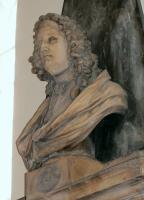
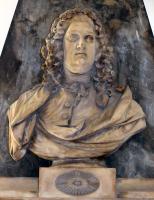
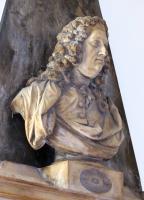
Jack William Rowan, d.1767.
- Jack William Rowan, d.1767, with long Latin inscription, and a bust of the deceased on top,
with an obelisk backing with his now black shield of arms above, and a nice Greek pot surmounting all.
The face of the bust looks to have been damaged and cleaned at some point, being strangely whitened
giving an uncomfortable aspect to it - it will look better with a century or so's grime - but nevertheless, a fine thing from the age of enlightenment.
His face is round, patrician, his eyes gazing slightly to one side, his mouth small and chin large,
giving a jowly but sophisticated look. The face is framed with the locks of the full wig. Below, he wears
a buttoned shirt with a Classical robe wound round on top, in a Baroque combination. The whole has an air of nobility and grandeur.
Beneath the monument, a smaller oval hangs, undecorated, commemorating two young granddaughters of William Rowan,
and an older grandson, d.1769.
- Ann Halford, d.1793, husband John William Halford, d,1796, and
John Thistleton, d.1800, ‘many Years in the Service of the Honourable East India Company’.
Black panel with simple fluted white side pilasters, a truncated pedimental top in yellow and black marble,
and below, shallow apron with sunburst. By this date, the central black panel was something of a throwback
to an earlier age, but the coloured Italian marble above is a favourite of funerary monuments,
right up until the Napoleonic Wars brought the importation to an end, and black and white became the norm.
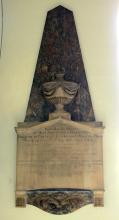 Obelisk monument to Ann Halford, typical late 18th Century.
Obelisk monument to Ann Halford, typical late 18th Century.
Plainer monuments, 18th Century:
19th Century monuments with carving:
- Ann Sophia Halford, d.1801, an infant, and father Carteret John Halford, d.1837,
with a tall obelisk in brecciated red brown marble, with a classical potion high relief in front.
Beneath, the apron contains crossed fronds of foliage and little flowers, rather finely done.
Minor carving on the brackets. A confident work. Obelisk monuments, or pyramid monuments, are widespread,
forming a grander alternative to a panel, and evocative of Egyptian ideas of rebirth.
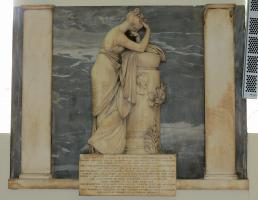
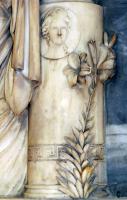 Flaxman's statue to Barbara Lowther, d.1805.
Flaxman's statue to Barbara Lowther, d.1805.
- Barbara Lowther, d.1805, 'sister of the Late Earl of Lonsdale,
the Late Countess of Darlington, and the present Duchess of Bolton', with a eulogy. Put up by Katherine Boulton,
the sister. Closely written panel with on top, a relief statue of a girl leaning against a pillar with a portrait
roundel of the deceased upon it, with a drape. The leaning girl, presumably the sister
(though by the 1800s there was often something of an ambiguity between allegorical figures and female relatives
in monumental sculpture), rests her forehead on one hand, the other, behind, being against her cheek and chin,
and both rest on the top of the pillar. Her arms are bare, and she wears light drapery which emphasises
rather than conceals the soft forms of her body. While her face is partly concealed by her hand,
her youth and beauty is indicated by her long, slender neck. We can see that her legs are crossed,
typical for such monuments, though to modern eyes looking too casual to be respectful. The drape on the top and one side of the pillar is balanced by a flower growing
on the other side. Most harmonious. The backing is of grey and white marble, and there are plain side pilasters
in lowe relief; we can presume there was once at least an entablature above. It is signed by John Flaxman no less - there is
a model for this charming piece in the Victoria and Albert Museum.
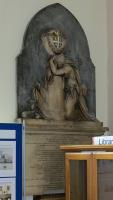
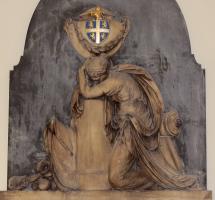 John Bacon Junior's sculpture for Major George Bean, d.1815.
John Bacon Junior's sculpture for Major George Bean, d.1815.
- Major George Bean, d.1815 at Waterloo, killed by a cannon ball.
With a nice figure of a girl collapsed against the tall, round pillar supporting a pot with a wreath.
We can only glimpse the upper face of the woman, buried in her arms – a nod to Flaxman’s earlier monument
where the girl’s face is also partially hidden – but her hair is finely rendered, held by a band at the front,
tied in a knot at the back, and she is youthful and ideal in a Greek fashion.
Her carved drapery is deeply undercut and hangs harmoniously, and at the back there are further drapes
covering some trophy arrangement behind the pillar; we see at least the fateful cannonballs
and the hilt of some weapon. A good piece, by the prolific monumental sculptor John Bacon Junior.
He made many such monuments, sometimes repeating designs fairly closely, but his work is generally skilful
and his girls beautiful, his drapery confident and ambitious. Under the monument is a brass panel to
Major Bean’s widow, Frances Eliza, d.1864, who afterwards married Captain Tomkinson;
the monument was emplaced in 1878, and is typical of this type of brass plaque, with black lettering,
and a wide repeating border, in this case with green splayed leaves, little fruits, and red quatrefoils
at the corners bearing crucifixes.
- Samuel Ward, d.1820, and wife Ann, d.1800, put up by their three sons.
Panel as a tomb chest end (thus looking like the end of a three dimensional box-shaped monument on small feet,
commonly found in churchyards, and known both as tomb chests and chest tombs), rather more elaborate than some,
with carvings of acanthus at the tops of the pillars, acroteria (‘ears’) directly above, a small central pot,
draped asymmetrically, and a shallow bifurcated apron with flowers between two brackets. All on a dark backing.
- Edmund Kean, d.1833, with a roundel enclosing a relief portrait of the deceased in profile,
with a curtain of drapery hanging either side.
- Samuel Paynter, d.1844, with an extra brass panel below in red and black text
to his only son, William Paynter, d.1879. The inscription on a pillar bearing a draped urn,
with on each side a nice angel, leaning against the pilar and looking outwards;
the combination of the two figures avoids symmetry in pose and clothing,
but makes a good undulating diagonal line across the two lower arms, sweeping down with the drapery
around the thigh of one figure, and upwards on the wing of the other. The overall effect is most restful.
The figures of the angels themselves are in a typical classical style of the earlier 19th Century,
one carrying an upturned, extinguished torch (symbolising extinction of life),
the other a severed leafy branch (life cut off short). But who was the sculptor of this good thing?
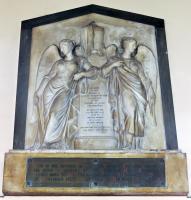
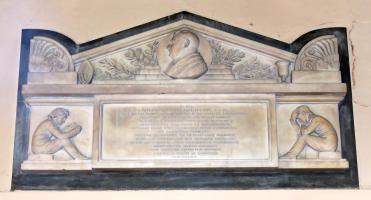 19th Century figure sculpture: Paynter and Delarosse monuments.
19th Century figure sculpture: Paynter and Delarosse monuments.
- Robert Marc Delarosse, as a broad, low panel with pediment and oversized acroteria
above two receding side panels bearing seated figures of boys in relief, one reading, the other thinking,
head resting on one hand. The pediment contains a portrait in relief of the deceased,
in front of a low wall with plants. An interesting piece, being another work by John Flaxman.
Plainer monuments, 19th Century:
- The Hon. Elizabeth Keene, d.1801, as a tomb chest end with little legs, shelf,
and pediment bearing a coat of arms.
- Gilbert Wakefield, d.1801, son of Revd. George Wakefield noted above,
with a long eulogy noting that he was imprisoned in Dorchester Prison for two years
‘for his Reply to the Address of the Bishop of Llandaff to the People of GREAT BRITAIN’.
Put up by his brother, Thomas Wakefield. White panel with curved pediment above a shelf on top,
with inscribed sunburst, and little apron and flanking brackets bearing carved flowers below.
- Dinah Baker, d.1805, daughter and sole Heiress of George Hayley, with a long inscription to her,
and husband Sir Robert Baker Bt, d.1826. As a tomb chest end, rather plain,
with a shield at arms.
- Thomas Wakefield, d.1806, with a eulogy explaining he was the minister of the parishioners
who put up the monument – white panel with upper pediment shape and a rim, lower ledge and an apron.
A rather meagre appearance.
- Mary Williams, d.1806, and sons ? Bigoe [Char]les Williams, d.1829,
and Thomas Williams, panel with upper shelf bearing an arched pediment with simple scrolly design in high relief,
all on a black backing.
- Revd. Norton Nicholls, d.1809, Rector of Lound and Bradwell, and late of Blundeston.
A plain white marble plaque with two small supporting brackets.
- William Selwyn, d.1817, with a short Latin inscription. Shelf above, narrow base and feet below,
on black backing with small bracket supports.
- Charles Price, Bt, d.1818, MP for Richmond, with long epitaph and codicil at the end to wife
Dame Mary Price, d.1838, and daughter Elizabeth Caroline Price, d.1853. With the crest of the family
in a wreath at the base, and an ornamented shelf above with a sort of a pediment on top.
By the stonemason Michael Crake of Portland Road, London. He was a fairly prolific worker, and his tablets are widespread: in central
London there are two works by him in St Giles in the Fields.
- Slingsby James, d.1831, young, with a eulogy, the monument put up by his parents.
Panel with upper shelf, and pediment with no edging, enclosing a carved classical pot. All on a dark shaped backing.
- Mungo Dick, d.1833, of Pitkerro in the County of Forfar N. B. [in Dundee].
Panel in the shape of a tomb chest end, with acroteria, and a central pot, nicely carved, with a shaped black backing.
By Edward Gaffin of Regent Street, London, and typical of that firm’s work. The firm of Gaffin was in Regent Street
for a century, and were perhaps the most prolific of all monument makers, mostly simple things with little sculptural ornament.
- Mary Mackenzie, d.1833, as a casket tomb end on a black backing, rather effectively done.
- Richard Jesson, d.1835, with a simple, chunky pediment above a shelf
bearing a heraldic device of an upwardly pointing upper arm and fist clutching a single flower.
Below, the equally chunky base has been removed; the outline can still be seen on the black backing.
Signed indistinctly by a mason with a London address
- Mary Gundry, d.1836. Plain panel on streaky grey marble backing.
- Mary Hayley, d.1838, and Louisa Hayley, d.1817, daughters of Sir Robert Baker Bt,
as a chunky tomb chest end, with rim, little flower feet, on a black backing. Signed by the stone mason,
whose name was too worn for me to read, but Regent St is distinguishable as the address, so conceivably Gaffin.
- Captain John Guyon, RN, d.1844, as a chest tomb end with little carved legs,
an upper shelf, and on top, a broad urn in high relief, very classical, on a shaped dark backing.
- Helen Duff, d.1844, plain white panel with black surround.
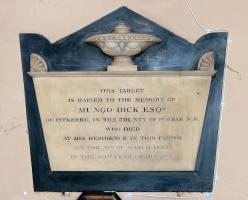
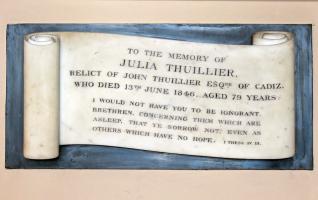 Black and white panels from mid-19th Century.
Black and white panels from mid-19th Century.
- Julia Thuillier, d.1846, wife of John Thuillier of Cadiz.
The inscription on white marble carved as an unwrapping scroll, unusually horizontal rather than vertical,
on a plain dark backing.
- Sir Charles Price, Baronet, d.1847, and wife Dame Mary Anne, d.1847,
white marble, chunky monument with concentric upper curved borders, and broad pilasters left and right,
acroteria at the top, tiny shell brackets at the bottom, and small lion rampant above the inscription, and shield below.
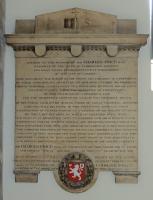 Sir Charles Price, Bt, d.1847.
Sir Charles Price, Bt, d.1847.
- William Selwyn, d.1855, and wife Laetitia Francis, d.1842, similar design.
- Lieut Col Mackinon, Capt Jolliffe, Capt Cust, Capt Bouverie,
and Capt Drummond, Officers 1853-6, of the Guards and Members of the Harvey, Richmond Lodge no 317,
of Virginia, who fell in the Crimea War, raised by that lodge of Freemasons. Panel with upper shelf on which rests a drape,
probably a flag over crossed weapons – difficult to see under scaffolding.
- Thomas Price, d.1859, magistrate, and wife Elizabeth, d.1840,
as a simple white tomb chest end with shelf, on a rectangular black panel. By Thomas Gaffin (brother of Edward).
- Deighton Piggott, d.1861, and Edwin Piggott, d.1868,
his brother, as a heavy panel with side pilasters, chunky entablature and top bearing a small cross,
and equally solid base, all on a black backing.
- Amelia Eliza Burdett, d.1866, simple tomb chest end on black backing
- Carol Jasper Selwyn, d.1869 and wife Hester, similar design.
20th Century Monuments:
- Emily Binney, panel in memory of her and to record that a chapel there,
dedicated to All Saints, was put up in 1904 by her husband. Alabaster with border and surround with little carved flowers
on square bosses. Characteristic of arts and crafts work of the period.
- Frederick Dalgarno Robinson, d.1904, with a pale marble frame decorated with little flowers
on square bosses, and gilded, as for the Binney panel above.
- Mary Elizabeth Maxwell, d.1915, ‘Miss Braddon’, a writer of 70 works of fiction,
the inscription informs us. Brownish panel with low relief portrait of the deceased, elderly and rather unflattering,
surrounded by a wreath of two crossed leafy branches. On a serpentinite background.
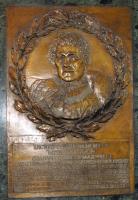 'Miss Braddon', relief portraiture, early 20th Century.
'Miss Braddon', relief portraiture, early 20th Century.
Also of interest:
We note en passant that there are several brasses, including a couple from the 17th Century,
with inscribed pictorial ornament, and among the 19th Century revival brasses, four Gothic pieces.
Outside, we note just a few monuments:
In front of the Church as it is approached from the street stands the Richmond War Memorial, a tall cross,
designed to be somewhat reminiscent of the style of an Eleanor Cross. Two short tiers of blank trefoil windows,
then the main stage, with tall thin windows and a small figure of a knight facing away from the church – he is Saint George,
with a small ruined dragon under his shield, and the wings up behind him like a cloak. He carries a tall sword,
and behind him is a halo (for lots of St George sculpture, see this page). All in a nice beige stone, which alas, seems to have been chosen for attractiveness
rather than durability.
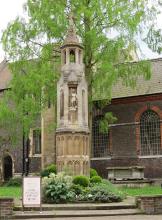
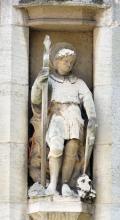 War Memorial, and figure of St George.
War Memorial, and figure of St George.
With thanks to the Church authorities for permission to show pictures of the monuments inside; their website is at
http://www.richmondteamministry.org/stmary/history-of-st-marys.
They asked me to stress that the information here represents my own opinions, and unrelated to the detailed current research being carried out by the Church authorities.
Top of page
Nearby on the Surrey borders are Kew Church // Mortlake Church // Twickenham Church // and York House Gardens, Twickenham
London sculpture // Sculptors // Introduction to church monuments
Angel statues // Cherub sculpture
Home
Visits to this page from 17 October 2015: 7,247









 Obelisk monument to Ann Halford, typical late 18th Century.
Obelisk monument to Ann Halford, typical late 18th Century.

 John Bacon Junior's sculpture for Major George Bean, d.1815.
John Bacon Junior's sculpture for Major George Bean, d.1815.

 19th Century figure sculpture: Paynter and Delarosse monuments.
19th Century figure sculpture: Paynter and Delarosse monuments.
 'Miss Braddon', relief portraiture, early 20th Century.
'Miss Braddon', relief portraiture, early 20th Century.

 War Memorial, and figure of St George.
War Memorial, and figure of St George.